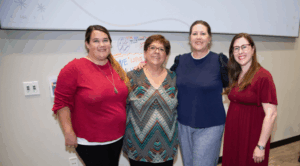HSU Students Study Rare Plants in the Texas Desert As Stewards of the Earth
Hardin-Simmons University students taking Dr. Rick Hammer’s May Term biology class, Chihuahuan Desert Field Ecology, are returning with a new appreciation of the rare plants known only to exist in West Texas.
Hammer, HSU assistant professor of biological and environmental sciences, and nine students anxious to learn more about the natural history of the southwest endured wind, downpours of rain, and a Copperhead snake during the week-long class.
Students set up their initial base camp in Balmorhea State Park Monday, May 19, 2014, and wrapped up the trip from Fort Davis State Park after seven days of field work and a heart-felt analysis of Genesis 2:15 and the U.S. Endangered Species Act adopted by Congress in 1973.
The focus of this year’s course was conservation biology. Hammer outlined a list of activities and discoveries made by students as they conducted a population survey of a rare plant called Dwarf Sandmat. The largest amount of it in the world is located on a one-mile stretch of highway south of Grand Falls, Texas.
“Texas Parks & Wildlife Department has not had the staff to monitor the plant and the population had not been verified since July 1960. My son Nathan and I rediscovered the historic population in July of 2013,” said Hammer.
It was after that relocation trip with his nine-year-old son that Hammer acquired a Texas Horned Lizard License Plate conservation grant so his students could determine the plant’s population in the desert. Even smaller patches of Dwarf Sandmat exist in Nolan, Mitchell, and Pecos counties of Texas.
“Students and I discussed why we should care about a particular species that is threatened with extinction. Congress passed the Endangered Species Act as an expression of our concern as a society with an ethical, ecological, scientific, and educational set of values. Students also discussed why our society should care about endangered species from the perspective of God’s creation and that God values his creation,” said Hammer.
In Genesis 2:15 the Bible instructs people to be stewards of the Earth. Hammer said students discussed how the natural world can be used for the benefit of humans but God instructs mankind to maintain it for current and future generations. Hammer said during prayers before evening meals students included recognition of these natural gifts and their desire to responsibly care for them.
“Living, working, and learning in this way brings students closer to what God has created and helps students appreciate their responsibility to care for our natural world,” said Hammer. “Without close-up encounters like this trip it can be hard to cultivate this perspective from our day-in and day-out urban lifestyles.”
Students also visited the Diamond Y Preserve, located north of Fort Stockton, owned by the Texas Nature Conservancy. The preserve protects one of the largest and last remaining desert marshlands, which provides a critically important habitat for a federally-endangered and rare desert fish, the Leon Springs Pupfish.
Other highlights of the trip included a visit to the Chihuahuan Desert Research Institute near Fort Davis and the Fort Davis National Historic Site. Students also visited Madura Canyon where Hammer encountered the not-so-rare but close-up find of a Copperhead snake. Hammer said, while poisonous, the snakes are not very aggressive and he was able to just back away.
Students also witnessed a meteor shower as Earth passed through the debris field of a comet in an unusually close flyby of Earth and attended a twilight program and star party at the McDonald Observatory near Fort Davis.
“I believe our students gained an appreciation for the biodiversity of the Chihuahuan Desert and for some of the species and habitats that are in peril in this region,” said Hammer. Just as the students were packing to leave the region they challenged each other to pass on to new generations the joys of the outdoors. “Kids really need to grow up with this heritage,” said Hammer.


